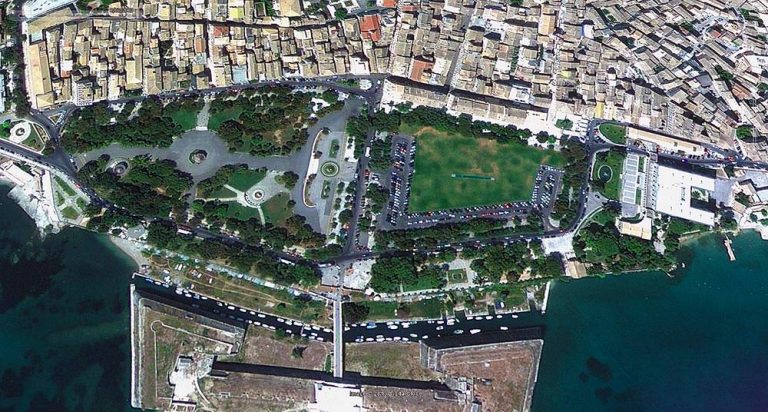Spianada Square (Esplanade) is the biggest square in Greece or even better the biggest in Balkan. The word “Spianada” came from the Italian word “spianare”, which means flatten and is connected with the Venecian’s decision to improve island’s defense by demolishing the surrounding houses.
As you approach the Old Town of Corfu, Spianada Square is the first thing you see; park your car in the first available spot and enjoy a fascinating walk in one of the most beautiful squares in Europe.
Its name originates from Italian word “Spianare” that means “to flatten”. The area used to be a fortification because it was necessary to have vacant area between the city and the castle. No construction was allowed to be made on this vast territory as any time military activities could take place there. It was finally shaped in 1628 and contributed in the constitution of concrete urban identity influencing the social life of Corfu. Unusual for Greece, Spianada has removed the city from the sea, creating however the liveliest part of modern life, combining trade, recreation, social activities and important happenings of the city. In the biggest open space of Spianada, you can see: Peristyle of Maitland, in the southern tip of Spianada is a simple, circular, ionic monument that was erected to honor the first English Commissioner Thomas Maitland (1816 – 1824). General and the Head of British forces of the Mediterranean, Maitland was the most difficult English Commissioner.
The peristyle as the type of monument was very popular at that time. It is the work of English military engineer G. Whitemore who also designed the Palace of Saints Michael and George, built from Maltese Stone.
The Union Square, where Easter Mass takes place and concerts from the Bands are given, while further down is the Monument of the Union of the Ionian Islands, dedicated to the union of the seven Ionian Islands with Greece, in 1864.
In the area in front of the bridge that leads to the Old Fortress, there are the statues of Schulenburg and Guilford. The marble statue of the German Marshall Schulenburg is the work of sculptor Gorradini and it was erected to honor the Marshall. His contribution was of great importance since he defended the city in the siege by the Turks in 1716.
In front of the Dorian peristyle of the Palace of Saints Michael and George, there is a bronze statue of Lord Frederick Adam, one of the well-known English Commissioners, who we know from the important technical work that he materialised for the city, like the aqueduct. The statue is the work of sculptor Pavlos Prosalentis. The characteristic movement of the statue’s hand towards the water that falls in the small lake refers to the English Commissioner’s important technical work in the city.
The cricket court occupies a big part of the square. The love of the Corfiots for cricket is of British origin from the period of English domination (1814-1864).
Nowadays it is one of the most popular places in town for visitors and the meeting point for most social gatherings. Three important historical periods are surrounding the square in stone: The City Palace that reflects the British era in the history of Corfu, The Old Venetian Castle and “French” Liston with its beautiful arches lightened by Venetian lanterns.
Sorry, no records were found. Please adjust your search criteria and try again.
Sorry, unable to load the Maps API.

